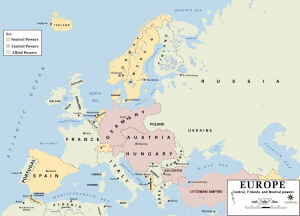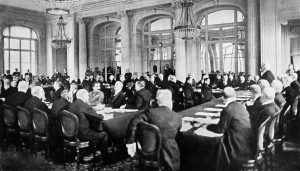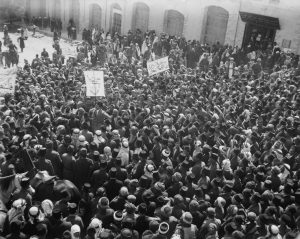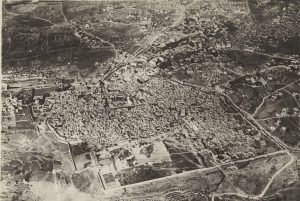
1910 AD to 1930 AD, Psalm 142: The Deflagration.
This site was first built in French (see www.147thgeneration.net). The English translation was mainly done using « google translation ». We have tried to correct the result of this translation to avoid interpretation errors. However, it is likely that there are unsatisfactory translations, do not hesitate to communicate them to us for correction.
(for that click on this paragraph)
(The Deflagration [1].)
Summary
This generation of the 1910s and 1920s.
According to our count, this generation is the 142th generation associated with Psalm 142. It is in this Psalm 142 that we therefore find an illustration of the facts of this generation.
Alliances between European countries are the preponderant ingredients of the explosion: “the first world war” which breaks out at the beginning of this generation.
This war sounded the death for various empires. Even before the end of the war, it was “the fall of tsarist Russia”.
“The impact of the Russian revolution on the Jewish population” is terrible, it is the designated victim of each of the actors of this revolution, whether they are the troops favorable to the czar or those which fight it. The results are catastrophic for the Jewish communities at the heart of the fighting.
The second empire to disappear is the Ottoman Empire. “The end of the Ottoman Empire” is marked by actions of the Ottomans towards the Jewish population of the Yishuv (future Israel), made worse by the actions of the mufti of Jerusalem.
The third empire to disappear is the Austro-Hungarian Empire. It results in “a new European map”. This favors the rise of nationalisms for which European Jews have no place.
In the Middle East, the dislocation of the Ottoman Empire also favors the “rise of Arab nationalisms”.
The picture is not dark enough. Foreshadowing of the next generation, the end of this generation sees “the emergence of fascist dictatorships” in Europe.
“Theodor Lessing’s forebodings” on the situation in Germany will unfortunately prove to be correct and this is noticeable at the end of this generation.
As the picture grows darker for the Jews of Europe. All the doors close, they cannot flee, no refuge. « The trap lies with the Jews of Europe » who will not be able to avoid the fate that awaits them for the next generation.
Talk
World War I.
Before this generation, European states, in addition to the arms race, increased the human strength of armies.
This added to the game of alliances bode of the worst: France is allied to England Russia and Italy. Germany is allied with the Austro-Hungarian Empire and the Ottoman Empire, two end-of-life empires.
Long before 1914, tensions are strong between the two blocks.


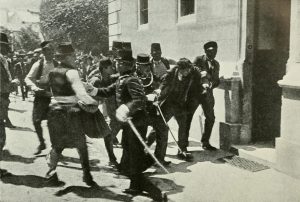
Thus an isolated student, Gavrilo Princip, manages to kill Archduke Franz Ferdinand with a revolver on June 28, 1914 in Sarajevo. Austria-Hungary, despite Germany’s reluctance, is looking for a confrontation with Serbia.
While this assassination goes for a fact without much impact everywhere in Europe, the war is emerging little by little. Austria-Hungary finally declared war on Serbia on July 29, 1914. Russia, Serbia’s ally, is preparing for war. William II took the lead: Germany declared war on Russia on August 1, 1914, then on France, allied with Russia, on August 3.
Germany thinking quickly to get rid of the French army after concentrating on the Russian front (Germany will succeed this plan in 39/40 but without overcoming the Russians) enters Belgium, a neutral country. This leads to the entry of Belgium, which no longer considers itself neutral because of the German action, then of England.

The assassination of Jean Jaurès on July 31 makes us lose hope that a gathering of « proletarians » of all countries prevents war.
All belligerents are confident about the swift and favorable outcome of the conflict. On August 12, France and England declare war on Austria-Hungary. Japan declares war on Germany, the United States will do so in April 1917.
The First World War has just begun.

The war will last four years and will bring millions of dead and wounded to all camps and will immediately result in the end of three empires; the Ottoman Empire, the Austro-Hungarian Empire and Tsarist Russia.
The fall of Tsarist Russia.
These three dislocations will each have In February 1917, the accumulation of Russian military setbacks and rationing led to a popular discontent with which the troops in charge of controlling them rallied.serious consequences on the Jews of these empires regardless of the effects of the Second World War that can be considered generated by the first.


Even before the end of the war, Russia is the first Empire to fall.
In February 1917, the accumulation of Russian military setbacks and rationing led to a popular discontent with which the troops in charge of controlling them rallied.
This first popular revolt pushes the Tsar to abdicate without alternative succession.
After several months of instability, Lenin and the Bolsheviks take power in October, promising, among other things, the end of the war. This was obtained from the Germans, who had greatly helped Lenin’s return to Russia in March 1918 at the price of heavy concessions (Treaty of Brest-Litvosk). Russia abandons all pretensions to Finland, the Baltic countries, Ukraine; it must cede territories to Turkey and pay a large war indemnity.
This external peace which allows the Germans to concentrate on the Western Front in France is not complete because a serious civil war takes place between the « white » Russians, associated with the conservatives, and the « reds » associated with the Bolshevik power which has meanwhile makes Moscow its capital at the expense of Petrograd.
For Russian Jews, war was a hope of emancipation. The setbacks of the Russian army, the advent of the Bolshevik regime and the resulting civil war are the source of unprecedented massacres in Jewish communities.
The impact of the Russian revolution on the Jewish populations
This could have resulted in making this generation of the 1910s and 1930s the blackest of the exile, but unfortunately this title will be reserved for the next generation, the 1940s and 1950s:
- For the necessities of war [2], nearly 700,000 Jews are enlisted in the Russian army. They hope to take advantage of the peace that has come to hasten their emancipation, a hope that the authorities do not deny. Russia wants to make the Allies feel that the anti-Jewish policy of the Tsars, against which so many protests were once raised in the world, could be transformed. The same hope is born from the decree of August 4, 1915, authorizing Jewish victims of the war to reside, temporarily, outside the area of residence, in any area of Russia. But all this is only a facade destined to give the change. In fact, the anti-Jewish persecutions do not stop, quite the contrary.
- During the three and a half years of war on the eastern front (August 1914 – February 1918), the martyrdom regions where the fighting takes place are those where the Jewish population is particularly dense. […] The provinces that constitute the area of residence allowed to Jews are in the thick of the fighting. The Jewish population represents about a fifth of the total. It is a non-peasant population, composed of small craftsmen or tradesmen, the first victims of any country invaded by the war.
- The number of resource-poor Jewish refugees seeking to flee into Russia is very high: 600,000 in 1915. In addition to the common misery of all, Jewish refugees are living an additional tragedy.

- For the Jews, with their Yiddish speaking akin to German, are immediately accused by the Russians of espionage in favor of the central powers. When the tsar’s troops entered Galicia in September 1914, Jews were immediately shot, others were arrested and deported to the other side of Russia. A few months later, when the Russians retreat, the Jews are scapegoats for defeat. Soldiers loot their homes and commit horrific killings in their path. (Displaced Jews are victims of famine and disease). In Vilna, for example, where 100,000 Jews took refuge, 10,000 died of hunger or disease during the winter of 1915-1916. […]
- (After the abdication of Czar Nicholas II) A provisional government is formed, which, as of April 2, 1917, repeals all anti-Jewish laws in force in Russia. Thus, with more than fifty years behind all other European countries, full citizenship is given to the Jews of Russia.
- This is an immense hope for Russian Jewish communities, who believe they see the dawn of freedom rise. […]

- But the euphoria is short-lived. […] The years immediately after the war, which are those of the civil war in Russia, will be for the Jews a period of great suffering. […]
- The October Revolution in Moscow, the departure of the German troops and the end of the war provoke, in the western part of Russia and especially in Ukraine, a chaotic situation, where the old bloody instincts are unleashed. For twenty months, Ukraine is the scene of violent struggles, where the only common denominator between the various opposing armies is the hatred of the Jews and the slogan of massacring them. But Ukraine, at that time, has 1.5 million Jews. The pogroms that unfold there are horrifying to all that Jewish history before Hitler has ever known.
- (After the first pogroms in January 1919), Proskurov’s pogrom (perpetrated by the Ukrainian armies led by Petlioura, which rejects both the Tsar and Lenin) is at the height of horror. The soldiers go from one house to another in Proskourov, slaughtering with swords in the most atrocious conditions as these testimonies show:
- Kibrik does better than speak … He specifies everything … One feels at home … a painful passion burns it, dries it. He tells me all right:
- The whole world must know.
- What? […] For example, what he suffered, him, Chalom Kibrik, 60, before whom the four soldiers killed killed the father, the brother, two girls.
- Who is a Christian? Who is Jewish? Asked the soldiers in passing.
- In the Kibrik, we are Jewish from father to son.
- Two swords on the father’s head, who dies. A blow on the head of the woman, who parries with her hand, has two fingers cut and the head split. The same blow to the 10-year-old girl, who is killed. The same blow to the girl of 18, who will die six months later. The same blow to the mother, who is half mad today. For the tuberculous brother and lying in bed, complete decapitation.
- […]
- On the turn of Jacob Aizmann (to testify). He brings with him the unforgettable horror.
- Right away, my father was killed. My mother was in bed with a 3 month old child. Protecting her, she had her hands and breasts cut off, and the child, skewered by a bayonet, fell to the ground. […]
- (Beirers testifies in turn) The atrocities accumulate, form an avalanche.
- The little Boris Barane, 4 years old. His bayonet was bayoneted like a bullet … Born a month ago, Siona Tepenbaum was pulled from the cradle, pierced by a bayonet.
The massacres continue even after the Ukrainian troops are defeated:
- A few days later [3], in a nearby town, Felstine, 500 Jews were exterminated in one day in the same way. Throughout the region, Jews are being slaughtered and the survivors are living a terrible nightmare. Orphans can not be counted anymore. Defeated by the Red Army, Petlioura recedes to make way for General Anton Denikin, who is marching on Moscow to bring back the Tsar. Supported by his Western allies, Denikin tries to seize Ukraine. He relies on the Cossacks of Don and Kuban; he receives his arms and ammunition from France and England. […] Denikin’s troops are just as eager for blood and pogroms. On their way, they savagely murder Jews, women are considered spoils of war and delivered to the bestiality of Cossacks raging. […]
- In early 1920, the Red Army pushed Denikin’s White Army back and the pogroms stopped. But in the spring of 1921, the bands of Petlioura again attacked and, before being finally put to flight by the Red Army, they still engaged in terrible massacres against the Jews in the suburbs of Kiev. The Red Army ends up being won over by this rage of pogroms, and in turn Denikin’s opponents, Boudienni’s troops, murder hundreds of Jews on their way.
The toll of the massacres during the three years of civil war is at least 100,000 Jews killed, some estimates are up to 300,000, the number of widows and orphans is innumerable. More [4] than 60% of Jewish children in Poland and Russia were orphaned between 1916 and 1920, the historian Yehuda Bauer estimates their number at 275,000.

Pogroms in this generation are not exclusive to Russian lands. The creation of Poland is to the detriment of Jewish communities:
- The entry [5] of Polish troops to Lvov / Lemberg took place in November 1918, in formerly Austrian Galicia. Polish officers allow soldiers to celebrate Poland’s independence by plundering Jewish homes for forty-eight hours. The results of these horror days: 73 Jews murdered and hundreds wounded.
The pogroms begin again in the early spring of 1919, when, after the Russian advance, the Polish troops take the counter-offensive and chase the Red Army. Their victorious entry into Pinsk and then into Vilna (April 19, 1919) is marked by massacres where the Jewish victims are numbered by dozens of deaths and hundreds of wounded. The 1920-1921 war against the Bolsheviks, in which the Poles are supported by the Allies, marks the climax of these killings. General Haller’s troops stand out in particular and, in real savage attacks, loot, mistreat and massacre Jews in more than 130 localities. Prime Minister Paderewski allows, despite protests in the Diet of Jewish deputies. When Polish stability is finally established, the Jewish population, decimated and bruised, is in a sorry state, materially and morally. […]
- The only radical remedy appears to be emigration.
The end of the Ottoman Empire.
Thus the end of the 14-18 war has consequences for the future of Europe and in particular for European Jewry. The participation of the Ottoman Empire alongside Germany in the war and its breakup following the defeat will also have great consequences on the life and future of the Jews living in the land of Israel and on the future of this Earth.
Thus already the entry into the war of the Ottoman Empire alongside Germany upset the settlement of Jews in Eretz Israel who fear to suffer the same fate as the Armenians.

This fear pushes Aaronsohn and others to ally with the English to suppress the yoke of the Turks. The English are also allied with Hussein of the Hijab, guardian of the holy places of Mecca and Medina. Lawrence of Arabia puts pressure on the latter and they organize a first offensive in March 1917. With this one, the exactions against the Jews, somewhat in regression in 1915 and 1916, take again of more beautiful.

Djemel Pasha orders the evacuation of Tel Aviv and Jaffa only for the Jewish population. The Jews retreat first to Petah-Tikva but are evacuated again and have to flee further.
After discovering the Nili network of Jewish intelligence in the service of the British in September 1917, the anger of the Turks is unleashed; they subject all Yishuv to the reign of terror: encircled villages, sudden arrests of many Jews accused of connivance with the English.


After a first failure in Gaza, the British take Beer-Shev’a, then simple oasis, then at the price of hard fighting of Jaffa, Lod and Ramle. On December 9, 1917, the English received the reissue of Jerusalem ending four centuries of Ottoman rule (1517-1917).
The population of Jerusalem is jubilant but decimated: in 1914, Jerusalem had 70,000 inhabitants including 45,000 Jews, in 1917, there are more than 60,000 inhabitants of which only 33,000 Jews.




At the end of this generation of the 1910s and 1920s, tensions between Arabs and Jews in the Land of Israel increased.
In 1929, serious incidents occurred on the wall of Jerusalem, excited by the mufti, thousands of faithful leaving the Al-Aqsa mosque on August 23 rushed on Jewish neighborhoods, incidents spread to Hebron where 59 Jews were murdered In all, there were 131 Jews killed by Arabs and 116 Arab victims, most of whom were shot by the British army.
The massacres perpetrated following the Russian revolution, as well as those perpetrated in the new Poland and the events affecting the Jews in the land of Israel justify the beginning of the psalm of this generation:

- A maskil of David, when he was in the cave, a prayer.
- [With] my voice, I cry out to the Lord; [with] my voice, I supplicate the Lord.
- I pour out before Him my speech; my distress I recite before Him.
The end of the Ottoman Empire and the Austro-Hungarian Empire with the redefinition of the European map are all sources of bad news for the Jews of this generation.
In Central and Eastern Europe, the defeat of Germany and its allies and the Russian revolution have resulted in a new definition of the European map in this region, especially to the detriment of the former Austro-Hungarian empire. This will have dramatic consequences for Jewish communities.
It is particularly the development of xenophobic nationalisms which, superimposed on the Second World War, will have disastrous consequences.
The peace signed at Versailles does not guarantee a bright future for Europe and the world. The divergent interests of the victorious countries contribute to the conclusion of a treaty which satisfies no one.
This peace is indeed not the best and the war of 14-18 will not be the « war to end all wars ». Already the next is preparing. If the First World War had almost spared the civilian population, it will not be the case of the second and among its people, the Jews will be all-purpose victims.
The Jews of Europe will be trapped, trap of which we can already discern the nets.
Outside Europe, Arab nationalism goes hand in hand with discriminatory measures for Jews. On the surface, the Jewish situation tends to normalize in Republican Turkey born of the Kemalist revolution of 1923, in Iran after the takeover of Reza Pahlavi in 1925 and in Egypt by King Fouad in 1922 This is also the case in Iraq and Transjordan with monarchs settled by the British or in Lebanon controlled by the French.
The rise of Arab nationalisms
But the rise of Arab nationalism suggests a less serene cohabitation for Jews in Arab countries:
- The turmoil [8] of the First World War marked the death of the Ottoman Empire and precipitated the crystallization of states from its dismemberment. The failure of the Arab uprising and the abolition of the caliphate by the Turkish parliament in 1924 all refer to the construction of its own legitimacy and the definition of the perimeter of its nation. Significantly, it is around the debate on « Islam and the foundations of power » launched in Cairo by Ali Abdel Raziq that appears under the pen Rashid Reda the neologism of Islamic State. If Turkey turns its back on the past, the religious referent is, however, at the heart of the construction of the states of the Arab peninsula, whether it is Arabia of Ibn Saud, marked by Wahhabism, or Zaydite Yemen of the Imam Yahya. In 1911, to symbolically mark his return to power after the departure of the Ottomans, it updates the discriminatory measures against Jews and restores the jizya. The « crowns » decree once again entrusted garbage collection to the Jews of Sana’a; that of the « orphans » provides for the conversion to Islam of orphaned Jewish children under the age of thirteen.
The joint participation of the Jews and Faycal’s troops in the British struggle against the Ottoman Empire could foreshadow a serene future for both Arabs and Jews. The English had made promises to everyone, but once the Ottomans were defeated, European interests took precedence.
In addition to the Arab reaction to the creation of a Jewish entity, the Christian world is beginning to react to it. The two monotheistic religions of Judaism are angry that Judaism may no longer be the fallen religion they describe.
Thus even before the actual creation of the State of Israel, Christians perceive the ideological danger that would represent an effective return of Jews to their land. They decide on a sacred union between Christianity and Islam to fight the rebirth of the theoretically fallen people. Thus, well before our time, anti-Semitism and anti-Zionism are dangerously mingled:
- The young [9] « Catholic Documentation », specialized in an anti-Jewish agitation both anti-Zionist and anti-Bolshevik, published a new file on « Zionism » in which, under the signature « Christianus » were listed the remedies:
- « It is necessary to create a » public opinion « in Christian countries […] it would be necessary to echo the moving complaint of the sovereign pontiff, it would be necessary to speak to these Christian nations of the Christian ideal, of the shame that there would be to give up under the political domination, disguised or not, of Judaism the cradle of their religion …
- « A second remedy … to persuade farmers not to sell their lands to the Jews, arguing that later these lands will have acquired a much higher value. A bank that would advance on mortgages … would do valuable services. «
- « Finally (I should say above all else) the union between Christians and Muslims is a necessity for salvation. »
- We recognize the main ingredients, which can be said to be timeless, of an anti-Zionist ideology, that a tenacious error arises in 1948-1949, and even more often in 1967.
The emergence of fascist dictatorships
The estimate [10] of war reparations in 1921 at 132 billion Gold RM (Gold Reichsmark) and the definition of the terms of repayment led to a rapid devaluation of the German currency.
If the German currency had withstood the war well (in 1913 it took 4,25 DM before war for a dollar and 8,9 just after) it quickly collapsed to 76 RM for a dollar in July 1921 to reach 9000 RM for a dollar in November. The German society, in disarray since the defeat is shaken by inflation, all those who are victims are easy recruits for the extremist parties. The state of the German economy forced him to postpone the payment of reparations, the Franco-Belgian troops occupy the Ruhr on January 11, 1923 which weakened the Weimar Republic and indirectly increased inflation: in August 1923 it was necessary to DM 4 600 000 for one dollar. This gives weight to the nationalist movements. The currency crisis came to an end in 1923.
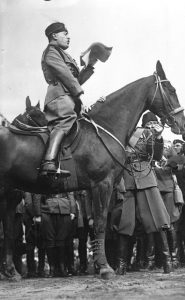
Meanwhile in neighboring Italy, fascism triumphs. The accession to power of the Duce Mussolini is a valuable example for Hitler who wrote in a letter dated February 5, 1915:
- (we hope) that those of us who will have the happiness of seeing the motherland, will find it purified of the metics (Fremdländerei), and that thanks to our sacrifices and our sufferings, thanks to the floods of blood that we pour daily face to an international world of enemies, not only will Germany’s external enemies be cut to pieces, but our internal internationalism will be crushed too. This would be more important than all annexations.

The disappointments generated by the Weimar Republic and resentment will facilitate the rise of Hitler, which creates a strong party consolidated by paramilitary organizations. After a first attempt to take power in 1923 in Bavaria, Hitler chose the democratic way to rise to power by earning his intentions early in Mein Kampf.
The catastrophe is being built, Theodor Lessing visionary sees it happen as it draws a dark picture of European and especially German Judaism.
Theodor’s forebodings

Theodor Lessing (1872-1933) [12], led an eventful existence in an unstable universe. His grandparents, like so many other Jewish families (who borrowed names of celebrities supposedly favorable to the Jews), had voluntarily taken the name of Lessing, that of the famous friend, not Jewish, of Moses Mendelssohn.
It is the whole issue of Emancipation, with its promises and its disappointments, that was looming behind this name change. This scholar did not hesitate to take sides, to interfere in public affairs, wanting to instruct the trial of the Weimar Republic, which provoked his life of wandering and, later, his brutal disappearance.
About the Jews, he said:
- But who is leading the (Jewish) community today? It is no longer the Sages of tradition, but the jurists! Since the end of the nineteenth century, Jews have taken great pride in the fact that so many of them have become ministers, chancellors, generals, high officials, eminent scholars, professors, theater directors, writers, and so on. We should be ashamed of those who have squandered the great wealth of our people. Because they were only the agonizing glow of an organ in decline. « They were only a short time in the sun of Europe where our nobility was burned. And Lessing concludes as follows:
- « Shame on all those sons who preferred to embrace this academic career or enter into literature for the luxury and comfort of the great cities of the West, instead of carrying the stones of the high road to Yeroushalayim. «
The findings of Theodor Lessing are a dramatic account of Heinrich Heine’s concerns about the risks of emancipation. They were realized throughout the nineteenth century to end at the beginning of the twentieth century Jews completely detached from their origins or rather trying to detach themselves. Jews experiencing a rather characteristic « hate of self », which is one of Lessing’s books describing the inordinate and vain efforts of the German Jews to erase their Jewishness and become true Germans.
A vain effort, as Lessing says about himself, a few days before his death in 1933:
- I was [13] a wise and smart young man. But I had noticed very early that even if I had been a thousand times wiser and more dapper, that is to say, a marvel in terms of character and work, everything, yes, everything, would have been vain . In their eyes, I was a stranger, I was a Jew. No work could have served me. If I had named myself Christian Stoffel, if I had been the offspring of a German peasant from Lower Saxony and a blonde woman, I would have been of the race of lords. That’s how I became an outcast.
In the Heinrich Heine generation (those of the 1810s and 1820s associated with Psalm 137), the psalmist had said, « If I forget you, O Jerusalem, may my right hand forget [its skill]. « . As Lessing notes, the Jews of Germany and much of Western Europe prefer the apparent and deceptive comfort of the banks of the Rhine (the banks of the rivers of Babylon) in Jerusalem and, overall, the alliance with the God of Israel.
Lessing as a perfect visionary predicts the coming catastrophe (already announced in Psalm 137: « may my right hand forget [its skill]« ) on European Judaism:
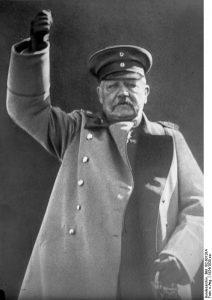
- On April 26, 1925 [14], the retired marshal, a citizen of Hanover (the city of Lessing) and honorary doctor of the Technical University, was elected president of the Reich in a popular vote […]. One day before the presidential election on April 25, Lessing had alluded, again in the « Tagblatt Prager », to the consequences of choosing Hindenburg.
- This article was fatal to him. He inflamed his persecutors. Surprisingly, in this text, Lessing still has a very friendly judgment on the old officer. Paul von Hindenburg, born in Posen in 1874, was eighty years old when he was elected president. He was re-elected on April 10, 1932, after the expiry of the first seven-year term. Hindenburg died in the exercise of his functions. On January 30, 1933, he called Hitler to become Chancellor. […]
Exactly seven years ago, in the first election, Professor Lessing, completely isolated, surrounded by the discredit and indignation of all (had predicted this outcome). […]
- It is not without a thrill that we read the words of the conclusion of the article as fateful as prophetic: « According to Plato, philosophers must be the guides of the people. With Hindenburg, it is not really a philosopher who would ascend the throne. Only a representative symbol, a question mark, a zero. Better a zero than a Nero, will we say? The story unfortunately shows that behind a zero is always hiding a future Nero. And it is Nero who will succeed to this zero: the Elector of Hindenburg will vote Hitler.
Ironically, Lessing was one of the first victims of the evil that he desperately tried to avoid and which is almost going to take all of European Judaism. Lessing is assassinated with a revolver on the evening of August 30, 1933, the day of the National-Socialist military parade triumphing in Nuremberg called « victory of faith » where 12,000 SS parade before Hitler
Lessing will not be the only victim of Nazism that emerges in this generation. Nazism that aims to erase on all levels Judaism and European Jewry.
It is this dark future that threatens the very existence of Judaism and the Jews and even their memory that evokes the following of the psalm of this generation:

- When my spirit enwraps itself upon me, and You know my path. In whichever way I go, they have hidden a snare for me.
The trap lies with the Jews of Europe
But as the future darkens for the Jews of Europe, all the doors are closing. The trap closes.
This is the case for the countries born on the rubble of the war of 14-18:
- The situation [15] of Jews in the new states gaining independence needs much clarification. The war has everywhere exacerbated nationalist and xenophobic feelings. Each nationality to which the Treaty of Versailles will grant independence tends to reject the Jews from within it. The Czechs claim that Jews are German, Slovaks say Magyars, Poles do not recognize them as theirs, and so on.
- Other minorities have similar problems, but they still have a protective state to defend them: the Germans of Poland have Germany, the Magyars of Slovakia Hungary, and so on. Only Jews can not have recourse to a tutelary metropolis.
This is also the case in the land of Israel:
- From 1920 [16], the incidents multiply between Jews and Arabs, and become more and more violent. Particularly serious riots broke out in Jaffa in 1921. […] From Jaffa, riots spread to Petah-Tikva, Rehovot, Hebron, Hedera, and threaten to spread to Galilee, Jerusalem. And even Nablus, where the ancient Samaritan community was almost expelled from the city if the English had not intervened in time. Reacting to these disturbances, Herbert Samuel immediately forbids the entry into the roadstead of Jaffa boats loaded with Jewish emigrants, forced to turn back to Istanbul: « We do not want a new Irish affair in Palestine », did he explained to his Zionist interlocutors, stunned, « No, it’s not Ireland, it’s Kishinev, it’s a pogrom, » they replied, that an anti-Semitic demonstration. […]
- The British government had come to the conclusion that peace in Palestine consisted in limiting the scope of the Balfour Declaration and the quota of Jewish immigration. Two new ideas that Colonial Secretary Winston Churchill personally came to explain to both sides in the aftermath of the 1921 riots.
This is also the case for the United States, the Russian revolution has consequences on the Jews of America. Americans who viewed it as positive saw no Jewish influence, which was not the case for those who would consider it dangerous:
- The aftermath of the war, distressing economic problems and well-orchestrated anti-Semitic propaganda resulted in restrictive immigration legislation, which, after the war, once again reached massive numbers in the past. A first law, in 1921, is reinforced in May 1924. It is commonly called « law of quotas ». From now on, for each ethnic group immigration is allowed only within the limit of 2% of the population that this group counted in the United States in 1890. But the flow of the Jewish immigration intensifies especially after 1890. The « law quotas « thus reduces the annual immigration to the annual figure of 10,000 or 11,000 per year against 50,000 in 1923. The rapid entry into force of the law, July 1, 1924, creates tragic situations for thousands of immigrants who were waiting for their departure in transit ports and are suddenly forced to wait a long time.
Following [17] these new rules of immigration to the United States, European Jews can not find refuge in the late 1920s. Thus in 1921, 119 036 Jews emigrated to the United States, 53 524 in 1922, 49 989 in 1923 and following restrictions, they are only 10 292 in 1924, oscillating around 11 000 until 1930. Emigration will fall even more between 1931 and 1936 (from 2,372 to 6,251 per year), 11 352 in 1937, then again from 1938 to 1941 and very weak in the final solution (about 10,000 in 1942 and about 22,000 in 1943 at the end of the war).
The trap that closes on the Jews of Europe with all the doors that close is the subject of the sequel of the psalm of this generation:

- Looking to the right, I see that no one recognizes me; escape is lost from me; no one seeks my soul.
The gestation of Israel
Despite this dismal record, this generation sees the return of Jews to Israel recognized by nations. The English when they needed to fight the Ottomans had made many promises to both the Jews of Palestine and the Arabs of Faycal’s troops, the latter seconded by Lawrence of Arabia.
Once the Ottomans were beaten, Westerners realized the value of the land on the Arabian Peninsula. After the discovery of the oil deposits, the English quickly forgot the promises made to the allies of yesterday. However, for the Jews of Palestine, the British maintained the will to return to Palestine via the Balfour Declaration.
It is likely that this one was primarily intended to amputate the French zone of influence in the East. The partition of Ottoman territories in the East provided for the allocation of Lebanon and Syria to the French, and Palestine was part of the province of Syria in Ottoman times.
The Entente Cordiale has its limits: the English, having prevented the French from becoming the first European power during the Treaty of Versailles, strives to reduce its influence in the East. For the Jews of Palestine, it is nevertheless the first stone for the creation of a Jewish state whose gestation will no longer be interrupted. This despite the turn of the British and the publication of many white papers reducing Jewish immigration to Palestine including in the worst periods of the next generation of the 1930s and 1940s.
At the time of the British conquest in 1917, there are only three hundred Arab families outside the walls of Jerusalem. A census of 1905 reported only one hundred and sixty. In 1912, the total population of Jerusalem comprises 45,000 Jews for 12,000 Muslims. The project is not at odds with Arab interests. Moreover, the Zionists of this generation, Ben Gurion included, dream of a successful coexistence between Arabs and Jews without any being wronged. Faycal, who was to govern the great Arab state from the fall of the Ottoman Empire and Weismann had agreed on this coexistence. The story of the creation of the state of Israel will be done with an almost general Arab hostility.
The gestation of the state of Israel that takes shape with the Balfour Declaration allows the psalmist to conclude this psalm on a note of relative hope:

- I cried out to You, O Lord; I said, « You are my refuge, my lot in the land of the living. »
- In the face of the dangers that come to the Jews, David turns to the Lord who alone can make the Jews are not erased on earth and still part of the living.
- Hearken to my cry for I have become very low; save me from my pursuers for they have overpowered me.
- If the Jewish people have faced powerful peoples throughout the night since the death of Solomon, the enemy that is forming is both the most powerful and the most inhuman of all time. Against him, without divine help, the Jews can only disappear.
- Take my soul out of confinement to give thanks to Your name; because of me the righteous will crown You, because You will recompense me.
- Europe has become a real trap for Jews. They are caught in the nets of the bird-catcher. The creation of the land of Israel where the surviving Jews can meet is the only hope. This land is the land of the Jews and the one where the divine presence must be manifested, the one where the Jews can pay homage to their God. When the Jews reclaim their land and rebuild Jerusalem to sanctify the name of God, the nations, or at least the righteous of the nations, can only pay homage to this work.
- Europe has become a real trap for Jews. They are caught in the nets of the bird-catcher. The creation of the land of Israel where the surviving Jews can meet is the only hope. This land is the land of the Jews and the one where the divine presence must be manifested, the one where the Jews can pay homage to their God. When the Jews reclaim their land and rebuild Jerusalem to sanctify the name of God, the nations, or at least the righteous of the nations, can only pay homage to this work.

[1] According to: Leon Poliakov: « History of Antisemitism, 2 – The Age of Science ». « The blast » is the title given by Leo Poliakov for the period 1914-1933. (French: « Histoire de l’antisémitisme, 2 – L’âge de la science ». )
[2] Renée Neher-Bernheim: « Jewish History of the Revolution to the State of Israel ». (pp. 690-740). Includes a testimony in the same book from « In the Land of Pogroms. » When Israel dies … « by Bernard Lecache. (French: « Histoire juive de la Révolution à l’État d’Israël ». (p. 690 à 740). Inclus un témoignage dans le même ouvrage extrait de « Au pays des Pogroms. Quand Israël meurt … » (p. 766 à 768 du même ouvrage) )
[3] Renée Neher-Bernheim: « Jewish History of the Revolution to the State of Israel ». (French: « Histoire juive de la Révolution à l’État d’Israël ». (p. 740,741) )
[4] Renée Neher-Bernheim: « Jewish History of the Revolution to the State of Israel ». (French: « Histoire juive de la Révolution à l’État d’Israël ». (p. 742) )
[5] Renée Neher-Bernheim: « Jewish History of the Revolution to the State of Israel ». (French: « Histoire juive de la Révolution à l’État d’Israël ». (p. 738,739) )
[6] From: Renée Neher-Bernheim: « Jewish History of the Revolution to the State of Israel » (French: « Histoire juive de la Révolution à l’État d’Israël ». (p. 660 à 667) )
[7] From: Simon Sebag Montefiore: « Jerusalem, Biography ». Chapter: « The British Mandate ». (French: « Jérusalem, Biographie ». Chapitre : « Le mandat britannique». (p. 521,522) )
[8] (Directed by) Antoine Germa, Benjamin Lellouch, Evelyne Patlagean: « The Jews in History ». Chapter of Frédéric Abécassis and Jean-François Faü: « Jews in the Muslim world ». (563).(French: « Les Juifs dans l’histoire ». Chapitre de Frédéric Abécassis et Jean-François Faü : « Les Juifs dans le monde musulman ». (p. 563) ).
[9] Leon Poliakov: « History of Antisemitism, 2 – The Age of Science ». (French: « Histoire de l’antisémitisme, 2 – L’âge de la science ». (p. 453,454) ).
[10] From: Henry Bogdan: « History of Germany ». (French: « Histoire de l’Allemagne ». (p. 353 à 364) )
[11] Leon Poliakov: « History of Antisemitism, 2 – The Age of Science ». (French: « Histoire de l’antisémitisme, 2 – L’âge de la science ». (p. 363) )
[12] Maurice Ruben Hayoun: « The enlightened figures, from Cordoba to Berlin (2) ». (French: « Les lumières de Cordoue à Berlin (2) ». (p. 568 à 574) ).
[13] Maurice Ruben Hayoun: « The enlightened figures, from Cordoba to Berlin (2) ». (French: « Les lumières de Cordoue à Berlin (2) ». (p. 578) ).
[14] Hans Mayer: « Germans and Jews: the revocation ». (121-122) (French: « Allemands et Juifs : la révocation ». (p. 121,122) )
[15] Renée Neher-Bernheim: « Jewish History of the Revolution to the State of Israel ». (French: « Histoire juive de la Révolution à l’Etat d’Israël ». (p. 735) )
[16] Michel Abitbol: « History of the Jews ». Chapter: « The end of a world ». (French: « Histoire des Juifs ». Chapitre : « La fin d’un monde ». (p. 519,520)).
[17] From: Renée Neher-Bernheim: « Jewish History of the Revolution to the State of Israel » (French: « Histoire juive de la Révolution à l’État d’Israël ». (p. 859) )
[18] Renée Neher-Bernheim : « Jérusalem, trois millénaires d’histoire ». (p. 156 et 168).

